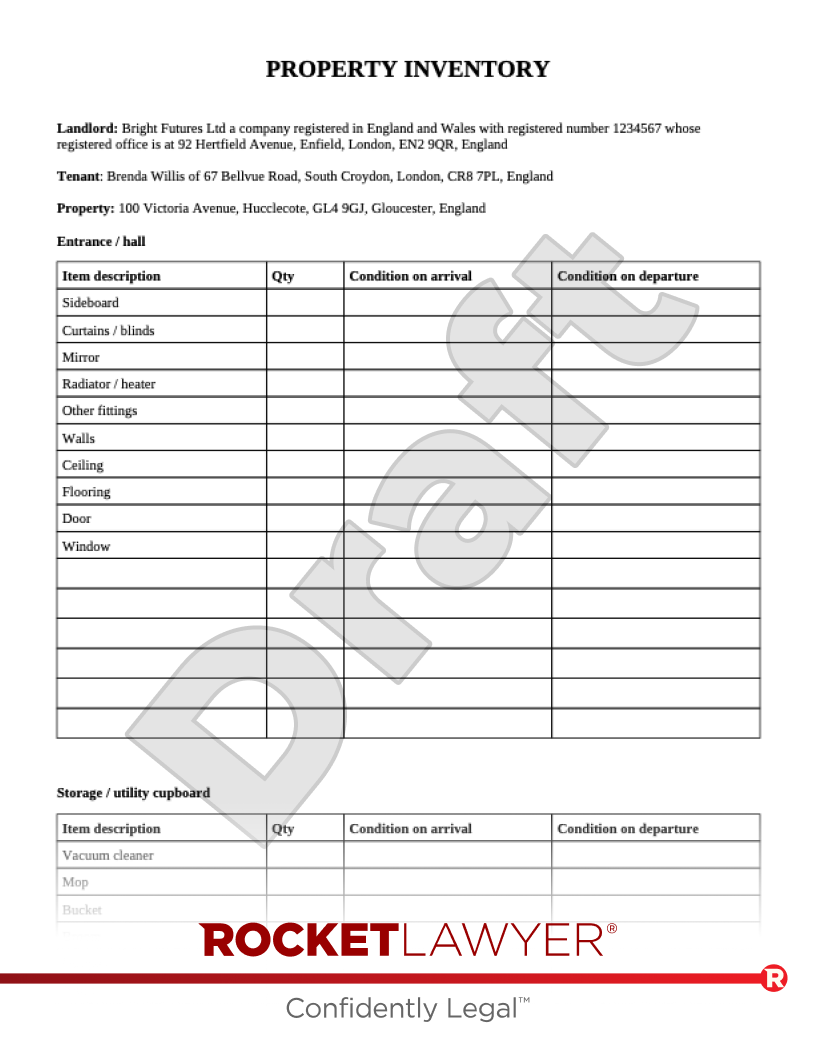MAKE YOUR FREE Inventory

What we'll cover
What is an Inventory?
When should I use an Inventory?
Use this Inventory:
-
when you want to let out a house or a flat
-
to record the condition of items within the property
-
when the property is furnished or unfurnished
-
when the property has up to 2 reception rooms, 4 bedrooms and 2 bathrooms
-
for properties in England, Wales or Scotland
Sample Inventory
The terms in your document will update based on the information you provide
PROPERTY INVENTORY
Tenant:
Property:
, ,
Entrance / hall
| Item description | Qty | Condition on arrival | Condition on departure |
| Sideboard | |||
| linds | |||
| Radiator / heater | |||
| Other fittings | |||
| Walls | |||
| Ceiling | |||
| Flooring | |||
| Door | |||
| Window | |||
Storage / utility cupboard
| Item description | Qty | Condition on arrival | Condition on departure |
| Walls | |||
Door | |||
Reception 1
| Item description | Qty | Condition on arrival | Condition on departure |
| Light fittings | |||
| Gas / electric fire | |||
| linds | |||
| Radiator / heater | |||
| Walls | |||
| Ceiling | |||
| Flooring | |||
| Door | |||
| Window | |||
Kitchen
| Item description | Qty | Condition on arrival | Condition on departure |
| Refrigerator | |||
| Freezer | |||
| Cooker / oven | |||
| Hob | |||
| Dishwasher | |||
| linds | |||
| Smoke alarm | |||
| Washing machine | |||
| Tumble dryer | |||
| Walls | |||
| Ceiling | |||
| Flooring | |||
| Door | |||
| Window | |||
Bathroom 1
| Item description | Qty | Condition on arrival | Condition on departure |
| Toilet | |||
| Hand basin | |||
| Bath | |||
| Shower | |||
| lind | |||
| Cabinet | |||
| Radiator / heater | |||
| Extractor fan | |||
| Walls | |||
| Ceiling | |||
| Flooring | |||
| Door | |||
| Window | |||
Bedroom 1
| Item description | Qty | Condition on arrival | Condition on departure |
| lind | |||
| Radiator / heater | |||
| Other fittings | |||
| Walls | |||
| Ceiling | |||
| Flooring | |||
| Door | |||
| Window | |||
Arrival inspection
| Date: |
Departure inspection
| Date: |
About Inventories
Learn more about making your Inventory
-
How to make an Inventory
Making an Inventory online is simple. Just answer a few questions and Rocket Lawyer will build your document for you. When you have all of the details prepared in advance, making your document is a quick and easy process.
To make your Inventory you will need the following information:
Party details
-
The landlord’s details (including, if applicable, your business’ legal structure and address).
-
The tenant’s name and current address (ie their address before they move into the new property).
Property details
-
The address of the property being rented out.
-
Is the property furnished or unfurnished?
-
Does the property have:
-
1 or 2 reception rooms?
-
1, 2 or 3 bathrooms?
-
1, 2, 3 or 4 bedrooms?
-
a garden?
-
Agent details
-
Will an agent sign the Inventory on behalf of the landlord? If so, what is the agent’s name?
-
-
Common sections in an Inventory
Inventories record the state of a rental property and the items in the property (if any) when a tenant first moves in. To do this, Inventories typically include:
Party and property details
At the top of the Inventory, the landlord’s and tenant’s details and the property in relation to which the Inventory is made will be set out. This helps ensure clarity as to what property the Inventory relates to.
Entrance/hall
This table provides a description of the items located in the property’s entrance and/or hallways. The landlord and tenant should record the quantity of each item (if an item is not relevant, it should either be deleted or crossed out) and its condition on arrival. On move-out, the condition on departure should be recorded and compared to the condition on arrival.
If the property doesn’t have an entrance/hall, this table should be deleted.
Storage/utility cupboard
This table provides a description of the items located in the property’s storage/utility cupboard. The landlord and tenant should record the quantity of each item (if an item is not relevant, it should either be deleted or crossed out) and its condition on arrival. On move-out, the condition on departure should be recorded and compared to the condition on arrival.
If the property doesn’t have a storage/utility cupboard, this table should be deleted.
Reception
This table provides a description of the items located in the property’s reception (or multiple receptions). The landlord and tenant should record the quantity of each item (if an item is not relevant, it should either be deleted or crossed out) and its condition on arrival. On move-out, the condition on departure should be recorded and compared to the condition on arrival.
Kitchen
This table provides a description of the items located in the property’s kitchen. The landlord and tenant should record the quantity of each item (if an item is not relevant, it should either be deleted or crossed out) and its condition on arrival. On move-out, the condition on departure should be recorded and compared to the condition on arrival.
Bathroom
This table provides a description of the items located in the property’s bathroom (or multiple bathrooms). The landlord and tenant should record the quantity of each item (if an item is not relevant, it should either be deleted or crossed out) and its condition on arrival. On move-out, the condition on departure should be recorded and compared to the condition on arrival.
Bedroom
This table provides a description of the items located in the property’s bedroom (or multiple bedrooms). The landlord and tenant should record the quantity of each item (if an item is not relevant, it should either be deleted or crossed out) and its condition on arrival. On move-out, the condition on departure should be recorded and compared to the condition on arrival.
Garden
If the property has a garden, this table provides a description of the items located in it. The landlord and tenant should record the quantity of each item (if an item is not relevant, it should either be deleted or crossed out) and its condition on arrival. On move-out, the condition on departure should be recorded and compared to the condition on arrival.
Arrival inspection
This section includes the date of the arrival inspection and details of the parties present during the property inspection. The parties should be the landlord (or their agent) and the tenant (or all tenants) moving in.
By signing the Inventory, the parties agree that the records made in the Inventory are accurate.
Departure inspection
This section includes the date of the departure inspection and details of the parties present during the inspection. The parties should be the landlord (or their agent) and the tenant (or all tenants) moving out.
By signing the Inventory, the parties agree to the records made in the Inventory.
-
Legal tips for making an Inventory
Complete your Inventory with sufficient detail
When completing your Inventory, be specific and detailed with your description of the items in the property and the property itself. For example:
-
the master bedroom walls are clean and have been freshly painted
-
the patio is weed-free
-
chips and surface scratches to the top surface of the dining table
-
minor scuff marks and light stains on the bathroom door
Any existing damage or defects should also be accurately recorded in the Inventory. Photographs may be added to supplement your inventory.
Where items differ in condition, make sure to record each item (and its condition) separately.
Consider taking photos and attaching them to your Inventory
Taking photos of the property and its items can help record their condition when the tenant first moves in. Attaching such photos to an Inventory is a good way to document an item’s condition to help prevent disputes when the tenant moves out.
Any photographs attached to the Inventory should also be signed and dated by the parties.
Make sure to discuss the Inventory with the tenant(s)
When inspecting the property and recording its condition in an Inventory, it is important that all parties agree on the conditions recorded. The property should be inspected together by all relevant parties (ie the landlord or their agent and all tenants) and the parties should have an open conversation about the state of the property. By ensuring that everyone agrees about the condition of the property, you can help prevent disputes down the line when the tenancy comes to an end.
Understand when to seek advice from a lawyer
Ask a lawyer for:
-
a property that is not residential
-
a property that has more than 4 bedrooms, 2 bathrooms or 2 reception rooms
-
Inventory FAQs
-
What is included in an Inventory?
This Inventory template includes:
-
a comprehensive list of the normal furnishings and fittings found in a house or flat
-
spaces to record the condition of carpets, walls and doors
-
spaces to record the condition of items and of the property at the start of the tenancy
-
spaces to record the condition of items and of the property at the end of the tenancy
-
-
Do I need an Inventory?
You need an Inventory to record the condition of items before the tenant moves in and before the tenant leaves to clarify what, if any, damages need to be paid for out of any deposit. An Inventory should always be made as it can be used to prevent disputes at a later time about the condition of items.
From 1 December 2022, landlords letting a property under occupation contracts in Wales must provide an Inventory setting out the property’s contents. This is the case even if the property is unfurnished.
-
What should be included in the Inventory?
For furnished properties, an Inventory should include all items in the property that the tenant can use. Any items in garages or sheds should also be listed.
The condition of all fixtures in the property (eg carpets, walls, floors, skirting boards and sinks) should also be recorded.
-
Is an Inventory still needed if the property is unfurnished?
An Inventory should be prepared even if the property is unfurnished. In this case, the Inventory will only record the condition of fixtures (eg carpets, walls, floors, skirting boards and sinks).
-
Who needs to sign the Inventory?
Each occupier of the property named on the Tenancy agreement must sign and date the Inventory as being correct. Any photographs should also be signed and dated.
-
What do you do with the Inventory when it is signed?
Each occupier named on the Tenancy agreement should be provided with a signed version of the Inventory.

Our quality guarantee
We guarantee our service is safe and secure, and that properly signed Rocket Lawyer documents are legally enforceable under UK laws.
Need help? No problem!
Ask a question for free or get affordable legal advice from our lawyer.





